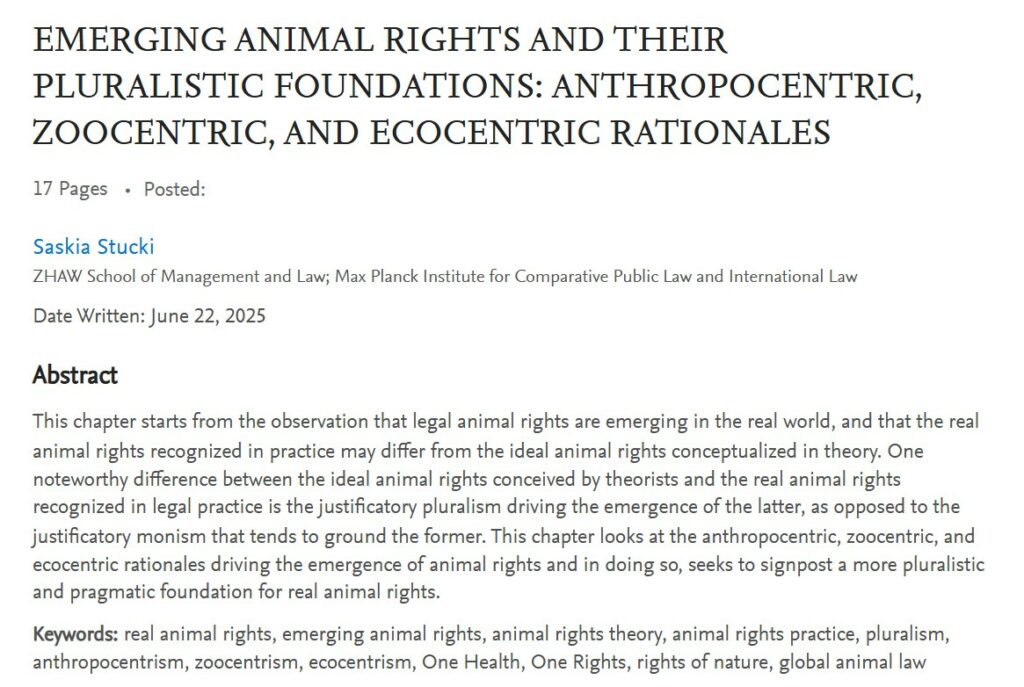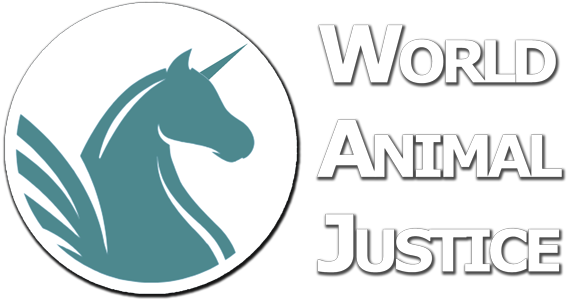How Emerging Animal Rights Are Reshaping Global Animal Law? Key Insights from Dr Saskia Stucki (2025)
Are animal rights a utopian ideal — or an emerging legal reality?
A powerful new analysis by the well-known animal rights law scholar Saskia Stucki — titled “Emerging Animal Rights and Their Pluralistic Foundations: Anthropocentric, Zoocentric, and Ecocentric Rationales”— answers this with compelling clarity: real animal rights are emerging — and multiplying.
At World Animal Justice, we see this work as an essential reference for lawyers, judges, lawmakers, and advocates committed to criminalising animal cruelty and enshrining animals as rights-holders in law. Below is our brief review.
👉 Source: Saskia Stucki, EMERGING ANIMAL RIGHTS AND THEIR PLURALISTIC FOUNDATIONS: ANTHROPOCENTRIC, ZOOCENTRIC, AND ECOCENTRIC RATIONALES (June 22, 2025). Avalaible at SSRN Here.
Forthcomingin Oxford Handbook of Global Animal Law, OUP 2026.
📜 Key Takeaway: Real vs. Ideal Animal Rights
Stucki clarifies an important distinction:
- Ideal animal rights are moral ideals — what animals ought to have.
- Real animal rights are actual, enforceable rights recognised by courts and constitutions right now.
This empowers courts and legislators to understand: what once seemed radical is already legal precedent.
🏛️ Where Real Animal Rights Are Already Law
Here’s how courts across continents have already transformed animal rights from theory into binding law
📌 Argentina: Legal Personhood for Great Apes
- Case: Cecilia the Chimpanzee
- Court: Third Court of Guarantees, Mendoza, Argentina (2016)
- Key ruling: The court held that Cecilia, a chimpanzee held in captivity in a zoo, was a non-human legal person and ordered her transfer to a sanctuary. The judge ruled:
“Great apes, like the chimpanzee, are sentient beings and therefore they have non-human rights […] Great apes are legal persons and owners of the inherent rights of sentient beings.”
👉 Significance: Cecilia was relocated to a sanctuary — the first such ruling in Latin America granting non-human legal personhood.
✅Read Cecilia Judgement (in Spanish)
✅ English Translation by Judge Mendoza
📌 Colombia: Legal Subjecthood and the Right to Liberty
- Case: Chucho the Bear
- Court: Supreme Court of Colombia (26 July 2017)
- Key ruling: The Court affirmed that animals are legal subjects, with the right to liberty among other protections. The judge explicitly questioned why legal personhood is extended to corporations — “inanimate entities” — yet denied to sentient, living beings.
👉 Significance: The ruling helped anchor animal protection in Colombia’s evolving framework of constitutional rights and environmental justice.
✅Read Chucho Judgement (in Spanish)
✅Read English Translation
📌 Pakistan: Habeas Corpus for Elephants
- Case: Islamabad Wildlife Management Board v Metropolitan Corporation Islamabad (W.P. No. 1155/2019)
- Court: Islamabad High Court (21 May 2020).
- Key ruling: The High Court used the habeas corpus writ — traditionally a human rights tool — to release Kaavan, an elephant held in solitary captivity at Islamabad Zoo. The court held that animals have natural rights to life and liberty protected under Pakistan’s Constitution.
👉 Significance: The court declared that animals are sentient beings with natural rights and directed the relocation of Kaavan to a sanctuary.
✅ Read Judgment on Kaavan — Islamabad High Court Decision
📌 India: Legal Personhood for Animals
- Case 1: Karnail
- Singh & Ors. v State of Haryana (2019)
- Court: Punjab & Haryana High Court
- Key ruling: Held that animals have a legal persona with rights comparable to humans under Articles 21 and 51A(g) of India’s Constitution.
✅ Read Judgment — Indian Kanoon
- Case 2: Narayan Dutt Bhatt v Union of India & Ors. (2020)
- Court: Uttarakhand High Court
- Key ruling: Declared the entire animal kingdom to be legal persons with corresponding human guardianship duties. Extended principles of parens patriae to protect animals.
✅ Read Judgment by Uttarakhand High Court — Indian Kanoon
👉 Significance: Courts imposed binding duties on humans to ensure the welfare and dignity of animals — transforming welfare provisions into subjective rights.
📌 Ecuador: Rights of Nature Extended to Individual Animals
- Case: Judgment No. 253-20-JH/22 — “Estrellita the Woolly Monkey”
- Court: Constitutional Court of Ecuador (27 January 2022).
- Key ruling: The Constitutional Court ruled that not only nature as a whole but also individual wild animals have constitutional rights under Ecuador’s Rights of Nature framework. Estrellita, a woolly monkey, was recognised as a rights-holder, and the court elaborated minimum standards for animal welfare consistent with constitutional rights.
👉 Significance: Ecuador became the first country where a Constitutional Court explicitly declared that individual animals possess enforceable constitutional rights, not merely collective ecosystem protection.
✅ Read Judgment on Estrellita (in Spanish) — Corte Constitucional de Ecuador
✅ English Translation by NHRP
🔑 Three Strong Foundations for Animal Rights
Stucki’s chapter clarifies why courts adopt animal rights using a pluralistic rationale:
1️⃣ Anthropocentric: Animals are protected to safeguard human interests — e.g., public health, climate stability.
📖 Example: WHO’s Animal-Human Interface Report on COVID-19 shows links between wildlife exploitation and pandemics.
2️⃣ Zoocentric: Animals are protected because they are sentient and intrinsically valuable.
📖 Example: Cambridge Declaration on Consciousness (2012) — widely cited in animal habeas corpus cases.
3️⃣ Ecocentric: Animals are protected as integral parts of nature and ecosystems.
📖 Example: Ecuador’s Rights of Nature clauses (Articles 71–74) and Estrellita ruling.
👉 Strategy tip: Combine these rationales in court and policy to appeal to broad audiences.
⚖️ A Path to Criminalising Animal Abuse
When animals are legal persons or rights-holders:
✅ Cruelty becomes a violation of rights — not just a property infraction.
✅ This empowers prosecutors and judges to treat serious abuse and exploitation as criminal offences.
Together, these build the foundation for Global Instruments to Legally Combat Animal Crimes — a priority for World Animal Justice.
🚀 Why the Global South Is Leading
📌 Argentina: Recognised a chimpanzee as a non-human legal person with inherent rights.
📌 Colombia: Declared animals to be legal subjects with rights such as liberty, rooted in constitutional reasoning.
📌 Ecuador: Extended constitutional Rights of Nature to individual animals.
📌 India: Courts declared all animals to be legal persons with enforceable rights and duties.
📌 Pakistan: Used habeas corpus for animals — blending human rights doctrine with animal protection.
👉 Takeaway: Animal rights are not a Western abstraction. They are a growing legal reality led by visionary courts across Latin America and South Asia — and offer a universal path toward meaningful animal justice.
📣 What This Means for Animal Rights Law Advocacy
✅ Lawyers: Use these cases as precedents in briefs, amicus curiae and public interest litigation.
✅ Lawmakers: Draft laws that convert welfare standards into subjective rights and criminal penalties.
✅ Advocates: Educate the public and policymakers: animal rights safeguard animals, humans, and the planet.
🌍 How to Legally Protect Animal Rights Worldwide?
➡️ Recognise animals as legal persons.
➡️ Criminalise animal abuse as crimes against rights-holders.
➡️ Anchor these norms into national and supranational laws.
✅ Conclusion: A Turning Point for Animal Rights — and for Us
Saskia Stucki’s timely analysis makes one truth impossible to ignore:
Animal rights are no longer just an ethical aspiration — they are an emerging legal reality across the globe.
From Pakistan’s groundbreaking habeas corpus for Kaavan the elephant, to India’s courts declaring animals as legal persons, to Ecuador’s Constitutional Court protecting an individual monkey’s rights under the Rights of Nature — the evidence is clear: the law is evolving to recognise animals not as property, but as living beings with enforceable rights.
This shift changes everything. When animals are recognised as rights-holders, cruelty and exploitation become legal violations — not trivial infractions, but crimes that demand prosecution and punishment.
This is the legal foundation for a true global prohibition of animal crimes.
At World Animal Justice, we stand ready to build on this momentum. We will push courts, lawmakers, and governments to:
✅ Expand real animal rights to all sentient beings.
✅ Prohibit animal abuses in every country.
✅ Embed these protections at the highest levels into constitutions and international treaties.
✅ Educate society on the need to protect everyone from all avoidable and preventable harm.
⚖️Animal rights strengthen human and nature rights. The time for debate is over — the time for action is now.
👉Animal rights are emerging. Animal crimes must globally end. Together, let’s build a world of justice for all.



